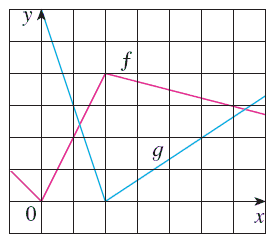Master Calculus 1 Practice Problems with Expert Help
What are the differences between e^x and e^ix both graphically and theoretically?And my second question is what is the precise intuition behind rotation of 2D number and exponential function?
Why the derivatives of exponential functions, lets say, as apposed to polynomials, grow more rapidly than the functions themselves?
i.e.
I am interested in a verbal explanation.
i.e.
I am interested in a verbal explanation.
"Factorials grow faster than exponential functions, but much slower than double-exponential functions."
The author doesn't provide a link let alone a proof of that fact and I don't find it obvious. After all, factorial functions grow really fast but the author says they grow much slower than double exponentials. Does anyone know a proof that
The author doesn't provide a link let alone a proof of that fact and I don't find it obvious. After all, factorial functions grow really fast but the author says they grow much slower than double exponentials. Does anyone know a proof that
Why is the expectation of an exponential function:
Prove for any real number k, prove that the exponential function is a bijection (z is a complex number) from the strip to the complex plane minus the point 0,
Is there a way to evaluate this integral with a lower limit K>0?
Is there a way to evaluate this integral with a lower limit K>0?
Is the exponential function continuous in ? How can one show this? Let's say for a function like
If f and g are the functions whose graphs are shown, let
u(x) = f(g(x)),
v(x) = g(f(x)), and w(x) = g(g(x)).
Find each derivative, if it exists. If it does not exist, explain why. (If an answer does not exist, enter DNE.)
(a)
u'(1) =
It does exist.u'(1) does not exist because f '(1) does not exist. u'(1) does not exist because g'(1) does not exist.u'(1) does not exist because f '(3) does not exist.u'(1) does not exist because g'(2) does not exist.
(b)
v'(1) =
It does exist.v'(1) does not exist because f '(1) does not exist. v'(1) does not exist because g'(1) does not exist.v'(1) does not exist because f '(3) does not exist.v'(1) does not exist because g'(2) does not exist.
(c)
w'(1) =
It does exist.w'(1) does not exist because f '(1) does not exist. w'(1) does not exist because g'(1) does not exist.w'(1) does not exist because f '(3) does not exist.w'(1) does not exist because g'(2) does not exist.
If f and g are the functions whose graphs are shown, let
u(x) = f(g(x)),
v(x) = g(f(x)), and w(x) = g(g(x)).
Find each derivative, if it exists. If it does not exist, explain why. (If an answer does not exist, enter DNE.)
(a)
u'(1) =
It does exist.u'(1) does not exist because f '(1) does not exist. u'(1) does not exist because g'(1) does not exist.u'(1) does not exist because f '(3) does not exist.u'(1) does not exist because g'(2) does not exist.
(b)
v'(1) =
It does exist.v'(1) does not exist because f '(1) does not exist. v'(1) does not exist because g'(1) does not exist.v'(1) does not exist because f '(3) does not exist.v'(1) does not exist because g'(2) does not exist.
(c)
w'(1) =
It does exist.w'(1) does not exist because f '(1) does not exist. w'(1) does not exist because g'(1) does not exist.w'(1) does not exist because f '(3) does not exist.w'(1) does not exist because g'(2) does not exist.
Definite integration of logarithmic function
I tried to proceed with this question using integration by parts but got stuck over
I tried to proceed with this question using integration by parts but got stuck over
The majority of Calculus 1 questions and answers that you will find below should be sufficient for understanding the basic rules that are necessary for problem-solving purposes. Take a look at the original answers, seek math assignment help, and compare them to what you have for your assignment.
If you need any other kind of help for your Calculus 1 tasks, combine several solutions or look at the problem that seems similar to your original assignment. If Math is not your subject per se, start with the most basic problems and proceed with the complex ones.

